Wednesday, January 23. 2008
Cold yesterday morning, and this hungry female Sharpie (maybe a Cooper's) missed a sparrow at my feeder but decided to puff up her feathers and stand on the grass for a while looking around. Wonderful the way they can turn their head to cover 360 degrees. This is the best I could do through Thermopane glass and a screen: 
Monday, January 21. 2008
Another view of the Rocky Mountain Front in Montana (more here). That's Ear Mountain. Been there. A.B. Guthrie's The Big Sky took place around there. (thanks, ap) 
Sunday, January 20. 2008
This is a reposting from one year ago: I do not have the provenance of this remarkable photo which came in over the transom, but it is clearly somewhere West. A gold star for the photographer who must have spend many patient hours watching this carcass in the snow. The picture tells the story: a Red Fox and a Magpie were happily dining on a deer carcass when Mr. Golden Eagle passed by. Does he believe that he can take a fox? I doubt that he can, but he can sure rattle his equanimity, and interrupt his luncheon. 
Yesterday, in CT: 
Saturday, January 19. 2008

Our piece on the strange Salton Sea reminded me of western Montana's not-strange but wonderful 1500-acre Freezeout Lake WMA (Wildlife Management Area) between Great Falls and Choteau, on the Rocky Mountain front. I have visited it twice, birding - not hunting. It's a small WMA, but packed with life. I have only been there in June, but during migration the shallow lake harbors over 300,000 Snow Geese and 10,000 Tundra Swans, not to mention everything else. Here's one guy's report of the geese. When I went, the birds that stood out were the Western Grebes dancing, the Avocets, the Phalaropes, and the Short-Eared Owls. Tons of breeding ducks. This place looks like a good place to stay, near the lake. Nice view of a cute butte. When I have been out that way for a week, I have stayed at the excellent, Nature Conservancy-run Pine Butte Guest Ranch. Photo above: Snow Geese over Freezeout, from this Snow Goose site
Thursday, January 10. 2008
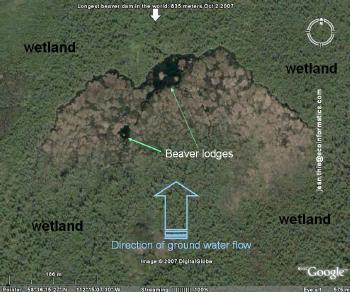 Where is the world's largest Beaver dam? Where is the world's largest Beaver dam?
We have heard the stories that the largest is somewhere in Three Forks, MT, but the best data I can find is that the largest is in Wood Buffalo Park in northern Alberta. It is 2790 feet, or about a half mile in length. It makes sense that the longest dams would need to be built on gently-sloping, slow-moving wetlands in order to impound a good volume of water, while most Beaver-sized streams can be effectively dammed with shorter lengths, or a series of shorter lengths, as in the photo below (from this excellent Beaver photo site): 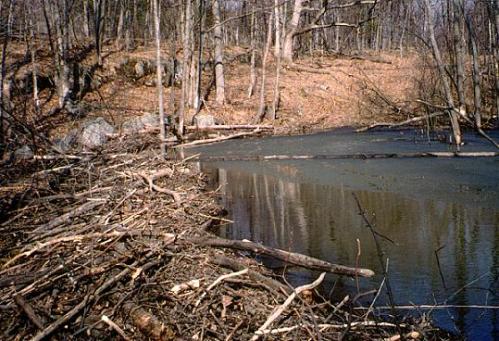
Sunday, January 6. 2008
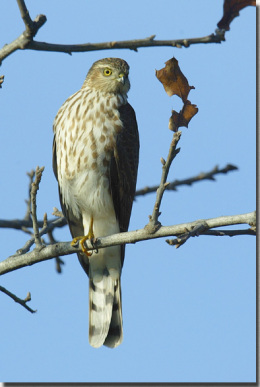 We have a few Sharp-Shinned Hawks in the neighborhood this winter who have decided not to bother flying further south, and that it is more energy-efficient to hang out here and to feed off the sparrows and Goldfinches around peoples' bird feeders. We have a few Sharp-Shinned Hawks in the neighborhood this winter who have decided not to bother flying further south, and that it is more energy-efficient to hang out here and to feed off the sparrows and Goldfinches around peoples' bird feeders.
I almost got a photo of one this morning, perched on the tray of my feeder three feet from my window. I could see the iris of her alert eye. She fled when I reached for my camera. Thus does my bird-feeder do double-duty, because I love seeing these small dive-bomber predators around the place. I have watched them catch a few delicious English Sparrows but they seem to miss their target most of the time despite their talent at crashing through shrubs in hot pursuit. It's too bad the Sharpies won't take some of my Grey Squirrels, but they are Accipters - hunters of birds on the wing. We human bird-hunters can relate: hunting is not shopping.
A CT salt pond yesterday, on Long Island Sound. Thanks, reader. 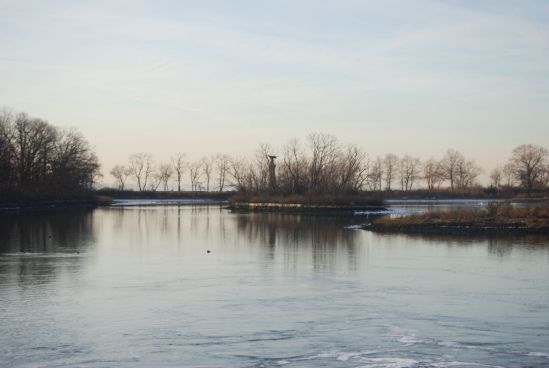
Wednesday, December 26. 2007
Tuesday, December 18. 2007
Killer Whales team up to break up the ice floe before making waves to roll their fresh seal sushi dinner into the water (h/t, Neurophilosophy):
Sunday, December 16. 2007
We have our first significant nor'easter of the year today here in Yankeeland. A collision of an arctic jet stream with warmer, moist air. Sleet and snow, and that tell-tale howling, blustery gale coming out of the nor'east. Wonderful. Why does the wind blow from the north-east for a type of storn which tends to travel in a north-eastern direction? It's because the center of the counter-clockwise spinning cyclone tends to settle off-shore, feeding off of the Gulf Stream, leaving us with the western side of the storm. (The off-shore winds, for those on ships and boats, would be blowing from the south). Here's Wikipedia on nor'easters.
Saturday, December 15. 2007
 I am a staunch nativist when it comes to wildlife. The damn English Sparrows are really bothering me this year. I am a staunch nativist when it comes to wildlife. The damn English Sparrows are really bothering me this year.
We have two pestiferous Limey bird species here in Yankeeland and in the US in general - the English Sparrow (aka House Sparrow) and the Starling. Both were imported from Albion for a variety of silly reasons, back before people realized that biological imports create a mess for native species. These were two highly aggressive, invasive species who have wreaked havoc on our gentle native birds. Now, the English Sparrow is the most widely distributed bird on earth. Today, my irritation is with the English Sparrow. It is not, in fact, a lowly, timid mouselike sparrow at all, but probably a variety of European weaver finch. They are city birds, barn birds, and may fit into European ecology quite well but here they drive out our native sparrows and are dominating my bird feeder this year. I have no interest in feeding them because they can do very well feeding from dumpsters in parking lots and eating horse manure - one of their favorite treats. As Beantown's Mayor Curley would have said, I'd ship them all back to England if I could. More about the House Sparrow at CLO here.
A reposting from November, 2006 Stone walls are "newer" in New England than the early enclosures, which were made of wood. Split logs, like ol' Abe used to make, but not post-and-rail. They were the criss-cross leany sort which rested the rails on tilted posts. And to keep animals out of the cottage garden, they used paling fences. But in post-glacial New England, where the fields seem to grow stones over the winter, you had to put the loose rocks somewhere, so why not make a wall? It is hard to walk through any woodland south of Maine without stumbling across an 18th century wall, and sometimes you find an old apple tree in the corner, or an old apple-tree trunk. No doubt planted by the farmer for home-made cider, which was the only kind of booze the average Yankee farmer could afford. This hilly, rocky woodland, as can easily be seen by the size and species of the trees in the photo, was pasture until about 40-50 years ago: it is a young beech and oak woodland, typical of acidic lowlands in New England, and well-past the point at which it is appealing to grouse and woodcock. Good for the wild turkeys, though. The booming deer population, alas, vacuum-cleans the undergrowth, making it inhospitable for lots of small critters and birds: either we eat those deer or we return wolves and mountain lions to New England. (I'd vote for all of the above.) These woods are dotted with low-lying vernal - and autumnal - pools, which are excellent for the toads, tree frogs, salamanders, Box Turtles, etc. "Wetlands," as some term them. I call them swamps, and I love them: they are a cradle of life. 
Friday, December 14. 2007

Look at the next two photos on continuation page - it gets worse.
Continue reading "Lake Superior in November"
Thursday, November 29. 2007
A re-post from 2005. The Red-Tail migration is in full force right now, and I am seeing them everywhere. I had one perched above my porch a week ago, eyes fixed on my bird feeder waiting for a squirrel.  The Red Tailed Hawk is the most commonly-seen hawk in the US and Canada, especially in winter when he likes to hang out along highways and in suburbs, on the look-out for rodents. His white chest is usually more noticeable than his rusty-red tail which is only seen from the back, or when he turns in flight and the sun catches it. The Red Tailed Hawk is the most commonly-seen hawk in the US and Canada, especially in winter when he likes to hang out along highways and in suburbs, on the look-out for rodents. His white chest is usually more noticeable than his rusty-red tail which is only seen from the back, or when he turns in flight and the sun catches it.
He is a "buteo" - the large, plump, soaring family of hawks with rounded wings (called buzzards in Europe). The Red Tail is a versatile creature, able to make a home even in NYC's Central Park, where "Pale Male" has been raising families for several years on rats and pigeons. This hawk's call is a distinctive "Keeeeeeer" which sends a chill down the spine of all little warm fuzzy critters. He'll take a pheasant from a shooting field, but his hamburgers are rodents - rats, rabbits, squirrels and mice. He will grab a foolish pigeon if he can. He is migratory, with population shifts south during winter, such that our New England winter birds are likely Canada breeders. Learn more about the mighty Red Tail: Click here: All About Birds

I cannot fulfill my usual editorial duties today because I will be busy getting ready for our annual conservation charity event tonight for Ducks Unlimited. Eleven million acres under protection for wildlife habitat, with no government money - that's a darn good cause. We will pre-post some useful new stuff today, and stuff from the archives. No dead air! Image: David Maas "Wood Ducks", over a DU Reclamation Project sign
Tuesday, November 27. 2007
Monday, November 26. 2007
This came in over the transom (thanks, C): Stuart Brown describes Norbert Rosing's striking images of a wild polar bear playing with sled dogs near Churchill, Manitoba on Canada's Hudson Bay.
The photographer was sure that he was going to see the end of his huskies when the polar bear materialized out of the blue, as it were: 
The rest of the photos and story on continuation page below:
Continue reading "Bear Story"
Sunday, November 25. 2007
 A repost from 2005: A repost from 2005:
Birding (it used to known as bird-watching but that didn't sound cool, and birders are of course cool) is the most popular and rapidly growing form of outdoor recreation in America. Besides all of the excellent birding handbooks that are out these days, the Cornell Laboratory of Ornithology has a good basic site for basic info and identification, All About Birds, which we use all the time. They also have an advanced site, The Birds of North America, which is by subscription. Other things that CLO offers: A home-study course on bird biology, behavior, and identification and the necessary A Field Guide to Bird Songs. Photo: Two warblers after banding. These are immature birds in fall plumage, a Mourning Warbler on top and a Connecticut Warbler below.
Friday, November 23. 2007
A re-post from April, 2005:  I keep a pair of cheap Nikon 7X35 compact binocs in the car, just in case I happen to encounter an interesting bird. They work very well as opera glasses, too. I keep a pair of cheap Nikon 7X35 compact binocs in the car, just in case I happen to encounter an interesting bird. They work very well as opera glasses, too.
For marine use - not for birding but for looking around - I like a 7X50. Mine are inexpensive but good enough, and with the exposure to salt water and banging, I don't want to worry about them. For more serious birding and nature-watching, I like my Minox rubber-coated 8X32s. Darn good lenses, and you don't want additional magnification for wildlife except in special circumstances. The cool birders who want to spend the money use Swarovskis - but the very best birders I know can ID any bird with any old cheap compact binoculars, unless they are distant, on a beach or prairie. Then a spotting scope is essential. Great source for binocs - Binoculars.com. They also have night-vision optics, spotting scopes, and rifle scopes. Photo: Swarovski 8X42s.
 Every five or six years our roses next to the house, warmed by the proximity and protected from the wind, manage to stay in bloom until Thanksgiving. With Thanksgiving so early this year, it's less surprising but still a delight to see them even though they are a bit ratty. Every five or six years our roses next to the house, warmed by the proximity and protected from the wind, manage to stay in bloom until Thanksgiving. With Thanksgiving so early this year, it's less surprising but still a delight to see them even though they are a bit ratty.
For other holiday news, I was amused to see a Sharp-Shinned Hawk hit our bird feeder yesterday, aiming for a White Throated Sparrow. He pursued the sparrow through the shrubs but finally emerged empty-handed. So much easier just to go to the Stop & Shop for one's Thanksgiving bird.
Tuesday, November 20. 2007
Massachusetts Hemlock woods a month ago. We have posted on Hemlocks here. 
Friday, November 16. 2007
 Canada Goose-looking birds come in widely different sizes and ornithologists, who love obsessing about taxonomy, have a lot of fun with the subject. Canada Goose-looking birds come in widely different sizes and ornithologists, who love obsessing about taxonomy, have a lot of fun with the subject.
The subject comes up because we shot quite a few Cacklers in Canada in October, which were probably what we used to call Hutchins' or Richardsons' Goose. These birds are high-Arctic breeders, and only winter on the East coast as rare vagrants. Bird Dog says he has seen them occasionally on the East coast. Their CLO link here. Photo: Canada Goose with Cackling Goose For the part of the Wikipedia entry which reviews all of the taxonomy, see continuation page below.
Continue reading "Goose of the Week: Cackling Goose"
Thursday, November 15. 2007
Why are my Sugar Maples different colors this week?  
Wednesday, November 7. 2007
Thanks to a loyal Yankee reader for this snap of a Great Black-Backed Gull on the blustery Connecticut coast this week with what I would identify as a small cold-water-loving Winter Flounder in his beak. A tasty sushi dinner for either man or bird. Our majestic Great Black-Backed is the largest gull in the world, and has been extending his range southward along the Atlantic coast for thirty years. Who knows why? But he competes effectively with our regular, abundant Yankee Herring Gull, a very fine, handsome, large and sturdy bird too, for whom Nor'easters and hurricanes are no big deal, and just an excuse for aerial acrobatics. 
|






 Where is the world's largest Beaver dam?
Where is the world's largest Beaver dam? 
 We have a few
We have a few 
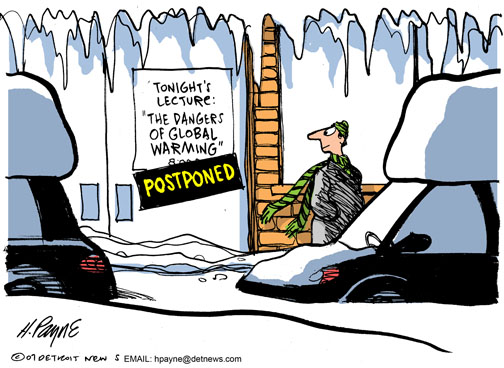
 I am a staunch nativist when it comes to wildlife. The damn English Sparrows are really bothering me this year.
I am a staunch nativist when it comes to wildlife. The damn English Sparrows are really bothering me this year.

 The Red Tailed Hawk is the most commonly-seen hawk in the US and Canada, especially in winter when he likes to hang out along highways and in suburbs, on the look-out for rodents. His white chest is usually more noticeable than his rusty-red tail which is only seen from the back, or when he turns in flight and the sun catches it.
The Red Tailed Hawk is the most commonly-seen hawk in the US and Canada, especially in winter when he likes to hang out along highways and in suburbs, on the look-out for rodents. His white chest is usually more noticeable than his rusty-red tail which is only seen from the back, or when he turns in flight and the sun catches it.


 A repost from 2005:
A repost from 2005: I keep a pair of cheap Nikon 7X35 compact binocs in the car, just in case I happen to encounter an interesting bird. They work very well as opera glasses, too.
I keep a pair of cheap Nikon 7X35 compact binocs in the car, just in case I happen to encounter an interesting bird. They work very well as opera glasses, too. Every five or six years our roses next to the house, warmed by the proximity and protected from the wind, manage to stay in bloom until Thanksgiving. With Thanksgiving so early this year, it's less surprising but still a delight to see them even though they are a bit ratty.
Every five or six years our roses next to the house, warmed by the proximity and protected from the wind, manage to stay in bloom until Thanksgiving. With Thanksgiving so early this year, it's less surprising but still a delight to see them even though they are a bit ratty.
 Canada Goose-looking birds come in widely different sizes and ornithologists, who love obsessing about taxonomy, have a lot of fun with the subject.
Canada Goose-looking birds come in widely different sizes and ornithologists, who love obsessing about taxonomy, have a lot of fun with the subject.

